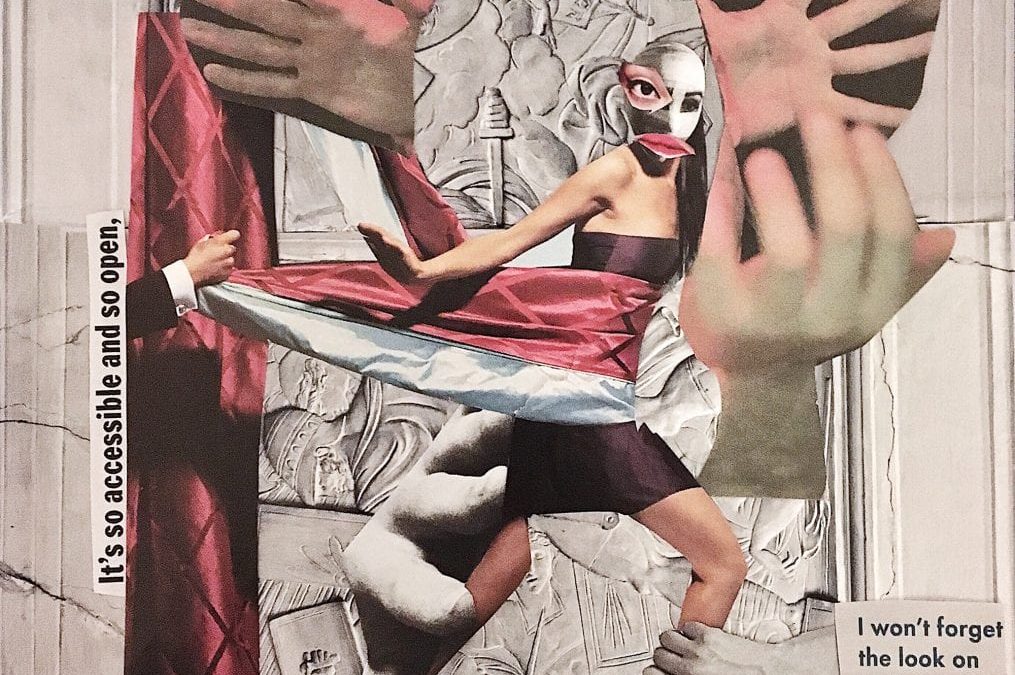“From birth, the species has taken possession of woman and tends to tighten its grasp.”
Art: Edited by Men and Girls by Montage Mädels
ART FEATURE: MONTAGE MADELS
We are an artist collective called the Montage Mädels. Our first meeting was 9 November 2016—the day after the US election. Although not all of our members are American, and we did not meet in the US, the effects of that night and into the early hours of the morning were felt around the world for months. We decided to organize and establish a creative resistance. Given our artistic predilection – all of us having studied art, design, and art history up to the graduate level—we felt our voice is best expressed through the non-verbal.
Handle It
“Just because the cause of most of these problems is isolated to one individual does not mean that the effects are isolatable. The true effect is closer to dropping poison into a glass of water than to dropping a pebble in.”
Contemporary media, digitized culture, global current events—anything that plagues our mind’s rationale or stirs our stomachs serves as our primary catalyst. Dada acts as the filter through which we feed our responses to these stimuli. We draw creative strength from the examples of the movement’s near-forgotten women, such as Hannah Höch, the Baroness Elsa von Freytag-Loringhoven, and honorary Dadaist Marianne Brandt. Barbara Kruger’s culture—jamming subversion of traditional capitalistic art formats and her recontextualization of pithy commercial language also greatly influence our work.
Wonderful People
“I think we have to look at ourselves… think about how do we display ourselves? How do we present ourselves as women? What are we asking? Are we asking for it by presenting all the sensuality and all the sexuality?”
Our pieces are counter-propaganda, denouncing today’s increasingly hate-driven ideologies and highlighting challenges presented by mass media culture. We are living in the eye of Debord’s spectacular storm, teetering on the brink of a new era of technology made of neural lace and predictive psychographic advertising. The world needs to prep for automatization, and yet instead we are closing in on ourselves, pulling up our drawbridges. The Montage Mädels strive to reinterpret the power of photomontage, resurrecting its tools and principles for our present time. Our works are at once analogue and post-net: we have resolved Walter Benjamin’s dialectic of the aura of the original artwork by destroying the original, supplanting it with a digital ghost. These ghosts critique their own social media framework, a digital space which democratizes the work of art, but also breeds homogeneity. We may claim our own non-commercialized, universal gallery space, but within it we are vulnerable, exposed to alternative numerical value, sluggishly striving for insta-stardom.
Shackles of Silence
“Hollywood blacklisted me because I got raped.”
Any advice you’d share with nascent artists:
We, like you, are still in our infancy. As such we are continuously developing our practice, with our devotion to our political/cultural mission remaining as a constant guiding principle. As such, it is necessary that we remain alert, sharp, and skeptical of the world around us in order to propel purposeful messages back into the data-storm web. Social media has provided artists with a platform to increase their accessibility allowing them to connect with one another, offering a great tool for collaboration. But use it wisely, and don’t be a slave to the dopamine released by your brain by the insta-likes. Likes are the opiate of the people.
Kunst, Free for All (Ode to the Japanese Idol Industry)
“In the idol industry there is a fixation on youthful girls, as young as nine or ten. There’s also a possessiveness that comes with that industry which is quite scary to encounter. The girls are basically
banned from having relationships.”
In our pieces, we experience the labour of sourcing, slicing, and placing the remnants of our present, collected from the streets, via the trails and footsteps of those who seek to influence our collective brain. We incorporate these media’s words and images to hold them to account, using them against themselves; we are directed by their ideas but not constrained by them. However, there are no identifiable faces in our work. It is ideas and not people that we seek to challenge. We slice apart their thoughts, forging new expressions and distorting their visions to reclaim toxic rhetoric. Dissembling each composition and saving the fragments, our work exists only in digital memory: at the final step of the creative process, each montage is at once photographically immortalised and destroyed. This dissolution cultivates further creativity, forging associations between each anonymously created piece.





